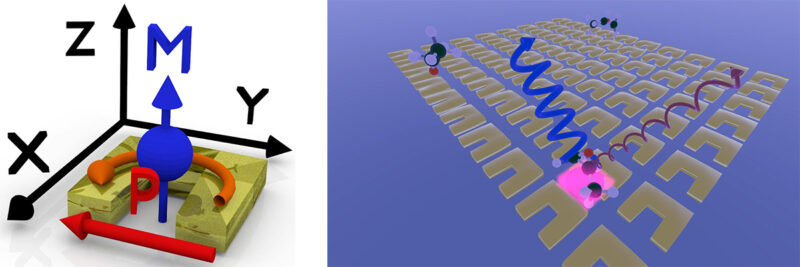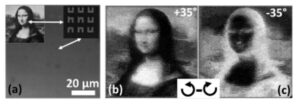List of members |
Facilities |
Internships and jobs |
PhD |
Publications |
News |
Team
- Permanent members: Bruno Gallas, Willy Daney-de-Marcillac, Mathieu Mivelle, Catherine Schwob
- PhD students: Obren Markovic, Homero Zapata, Shuhui Yang
Our research focuses on the control of the polarization state of light with the use of nanostructured materials, in particular with plasmonic resonators. Our activities cover all the aspects of the control of the polarization, from samples fabrication to polarimetric characterizations and modelling. From the fundamental point of view, we are describing the relation between the symmetries of the plasmonic modes excited in metallic nanostructures or the coupling among the nanostructures and the polarization state of the radiated light, with emphasis on creating circular polarization. From an applied physics point of view, we are investigating the use of circular polarization for the detection of biomolecules for medical applications as well as for the design of covert images for anticounterfeit tags.
Detection of biomolecules
Low cost, small footprint detector for fast and sensitive screening of biomolecules with enantiomer sensitivity would greatly benefit from the engineering of the polarization state of the electromagnetic fields at the nanoscale. We are developing new sensitive surfaces based on functionalized plasmonic resonators exhibiting magneto-electric coupling. Our work covers numerical investigations, sample realization and polarimetric detection of the presence of biomolecules.

Figure 1 : (Left) Schematic of the instantaneous current distribution in a U-shaped resonators and electric and magnetic dipole moments induced. (Right) Illustration of the interaction of a chiral molecule with U-shaped resonators and its consequences on the circular polarizations radiated.
Polarized images
The possibility to covert images in the polarization state of light relies on the realization of highly anisotropic photonic resonators. We are developing surfaces with spatial control on the polarization state of light, with emphasis on circular polarization, to design pixels that would reveal images only in particular observation conditions. Our activities cover the design of independent pixels, the realization of images encoded in the spatial control of photonic resonators and the observation of covert images.

Figure 2 : (a) Surface composed of pixels containing 3×3 straight and inverted U-shaped resonators observed in unpolarized light. The insert at the top left shows the hidden coded image. Each pixel of this image to be coded has been transformed into a surface containing a number of U resonators proportional to the gray level of the initial pixel (insert at the top right). (b) and (c) Same surface observed at a wavelength of 650 nm in circular dichroism at an incidence of +35° and -35°. The hidden image is now fully visible.
Fait d’actu Le sourire caché de la Joconde (2018)
Funding agencies
- ANR NANODIELLIPSO (2009-2013)
- ANR CHiROptMol (2018-2023)
- Labex MATISSE (2018-1019)
- PHC Aurora (2019)
Recent publications

